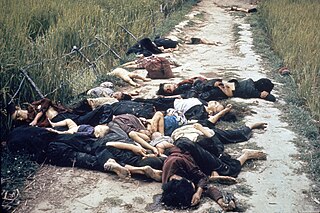
The My Lai massacre was a war crime committed by United States Army personnel on 16 March 1968, involving the mass murder of unarmed civilians in Sơn Tịnh district, South Vietnam, during the Vietnam War. Between 347 and 504 civilians were killed by U.S. soldiers from Company C, 1st Battalion, 20th Infantry Regiment and Company B, 4th Battalion, 3rd Infantry Regiment, 11th Brigade, 23rd (Americal) Infantry Division. Victims included men, women, children, and infants. Some of the women were gang-raped and their bodies mutilated, and some soldiers mutilated and raped children who were as young as 12. It is the largest publicized massacre of civilians by U.S. forces in the 20th century.

The First Indochina War was fought between France and Việt Minh, and their respective allies, from 19 December 1946 until 20 July 1954. Việt Minh was led by Võ Nguyên Giáp and Hồ Chí Minh. Most of the fighting took place in Tonkin in Northern Vietnam, although the conflict engulfed the entire country and also extended into the neighboring French Indochina protectorates of Laos and Cambodia.
An Amerasian may refer to a person born in East or Southeast Asia to an East Asian or Southeast Asian mother and a U.S. military father. Other terms used include War babies or G.I. babies.

Estimates of casualties of the Vietnam War vary widely. Estimates can include both civilian and military deaths in North and South Vietnam, Laos, and Cambodia.

Ronald L. Haeberle is a former United States Army combat photographer best known for the photographs he took of the My Lai Massacre on March 16, 1968. The photographs were definitive evidence of a massacre, making it impossible for the U.S. Army or government to ignore or cover up. On November 21, 1969, the day after the photographs were first published in Haeberle's hometown newspaper, The Cleveland Plain Dealer, Melvin Laird the Secretary of Defense discussed them with Henry Kissinger who was at the time National Security Advisor to President Richard Nixon. Laird was recorded as saying that while he would like "to sweep it under the rug," the photographs prevented it.
The Three Alls policy was a Japanese scorched earth policy adopted in China during World War II, the three "alls" being "kill all, burn all, loot all". This policy was designed as retaliation against the Chinese for the Communist-led Hundred Regiments Offensive in December 1940.
Koreans in Vietnam form an unrecognized minority group in Vietnam.

Prostitution in Vietnam is illegal and considered a serious crime. Nonetheless, Vietnam's Ministry of Labour, Invalids and Social Affairs (MOLISA) has estimated that there were 71,936 prostitutes in the country in 2013. Other estimates puts the number at up to 200,000.
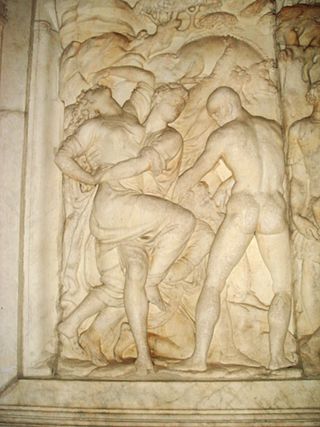
Wartime sexual violence is rape or other forms of sexual violence committed by combatants during an armed conflict, war, or military occupation often as spoils of war, but sometimes, particularly in ethnic conflict, the phenomenon has broader sociological motives. Wartime sexual violence may also include gang rape and rape with objects. It is distinguished from sexual harassment, sexual assaults and rape committed amongst troops in military service.
Lai Đại Hàn is a term used in the Vietnamese language to refer to a person who was born to a Vietnamese mother and a South Korean father during the Vietnam War. The births of these people occurred because of South Korean involvement in the Vietnam War; approximately 350,000 South Korean soldiers were deployed to South Vietnam between 1964 and 1973. It is a politically significant term with regard to South Korea–Vietnam relations and carries a heavy social stigma due to the fact that wartime sexual violence was endemic in Vietnam when these people were conceived. A large number of Lai Đại Hàn births were the result of pregnancies from rape, as various studies have determined that around half of all sexual encounters involving South Korean soldiers and Vietnamese women were not consensual. The community has faced unequal and discriminatory treatment from the Vietnamese government, while the South Korean government has refused to acknowledge and address the rape of Vietnamese women during the conflict.
Members of the United States Armed Forces have violated the law of war after the signing of the Hague Conventions of 1899 and 1907 and the signing of the Geneva Conventions. The United States prosecutes offenders through the War Crimes Act of 1996 as well as through articles in the Uniform Code of Military Justice. The United States signed the 1999 Rome Statute but it never ratified the treaty, taking the position that the International Criminal Court (ICC) lacks fundamental checks and balances. The American Service-Members' Protection Act of 2002 further limited US involvement with the ICC. The ICC reserves the right of states to prosecute war crimes, and the ICC can only proceed with prosecution of crimes when states do not have willingness or effective and reliable processes to investigate for themselves. The United States says that it has investigated many of the accusations alleged by the ICC prosecutors as having occurred in Afghanistan, and thus does not accept ICC jurisdiction over its nationals.
Allied troops committed a number of rapes during the Battle of Okinawa during the last months of the Pacific War and the subsequent Allied occupation of Japan. The Allies occupied Japan until 1952 following the end of World War II and Okinawa Prefecture remained under US governance for two decades after. Estimates of the incidence of sexual violence by Allied occupation personnel differ considerably.

As Allied troops entered and occupied German territory during the later stages of World War II, mass rapes of women took place both in connection with combat operations and during the subsequent occupation of Germany by soldiers from all advancing Allied armies, although a majority of scholars agree that the records show that a majority of the rapes were committed by Soviet occupation troops. The wartime rapes were followed by decades of silence.

South Korea and Vietnam established formal diplomatic relations on 22 December 1992, though the two countries had already had various historical contacts long before that. According to Vietnamese Prime Minister Phan Văn Khải, "The Republic of Korea is a very important partner of Vietnam and a good model for Vietnam to expand cooperation and exchange experiences during its development process." On 2022, South Korea and Vietnam upgraded their relationship in to "comprehensive strategic partnership", became the fourth country after China, Russia and India to do so.
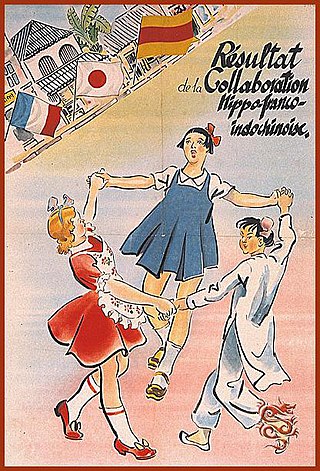
In mid-1940, Nazi Germany rapidly defeated the French Third Republic, and the colonial administration of French Indochina passed to the French State. Many concessions were granted to the Empire of Japan, such as the use of ports, airfields, and railroads. Japanese troops first entered parts of Indochina in September 1940, and by July 1941 Japan had extended its control over the whole of French Indochina. The United States, concerned by Japanese expansion, started putting embargoes on exports of steel and oil to Japan from July 1940. The desire to escape these embargoes and to become self-sufficient in resources ultimately contributed to Japan's decision to attack on December 7, 1941, the British Empire and simultaneously the USA. This led to the USA declaring war against Japan on December 8, 1941. The US then joined the side of the British Empire, at war with Germany since 1939, and its existing allies in the fight against the Axis powers.
The South Korean government, under the regime of Park Chung Hee, took an active role in the Vietnam War. South Korea's decision to join resulted from various underlying causes, including the development of US-South Korea relations, political exigencies, and the promise of economic aid from the United States. Under the wartime alliance, the South Korean economy flourished, receiving tens of billions of dollars in grants, loans, subsidies, technology transfers, and preferential economic treatment. Under the American wartime alliance, South Korea saw economic expansion due to significant financial assistance, such as grants, loans, subsidies, technology transfers, and advantageous economic policies provided by the United States. From September 1964 to March 1973, South Korea sent some 350,000 troops to South Vietnam. The South Korean Army, Marine Corps, Navy, and Air Force all participated as an ally of the United States. The number of troops from South Korea was much greater than those from Australia and New Zealand, and second only to the U.S. military force for foreign troops located in South Vietnam. The military commander was Lieutenant General Chae Myung-shin of the South Korean army. Participation of Korean forces in the war included both non-combatant and combatant roles.

Kim Bok-dong was a human rights activist that campaigned against sexual slavery and war rape. She was a young woman who was put into sexual slavery by the Japanese Imperial Army; a military that recruited girls between the ages of 10 and 18 years of age from colonized and occupied countries from the 1930s until the end of World War II. From age 14, she was put into comfort stations for eight years across different countries in Asia. Her experiences led her to become an activist; advocating the end of war-time sexual violence, anti-imperialism, workers' rights, and inter-Korean reconciliation. Along with the other "comfort women", she made the three-fold demand from the Japanese government: a formal state-level apology, reparations, and correction of Japanese history. In addition, Kim Bok-dong herself also supported other "comfort women" to step forward, and was a spokesperson in the "comfort women" movement. Kim Bok-dong died in Seoul, South Korea, in a hospital on January 28, 2019.
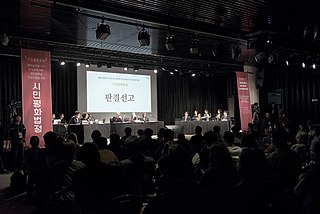
The People's Tribunal on War Crimes by South Korean Troops during the Vietnam War was a citizen's tribunal organised by South Korean social organizations including Minbyun, Korea-Vietnam Peace Foundation, The Korean Council for the Women Drafted for Military Sexual Slavery by Japan during 21–22 April 2018.

Women in the Vietnam War were active in a large variety of roles, making significant impacts on the War and with the War having significant impacts on them.
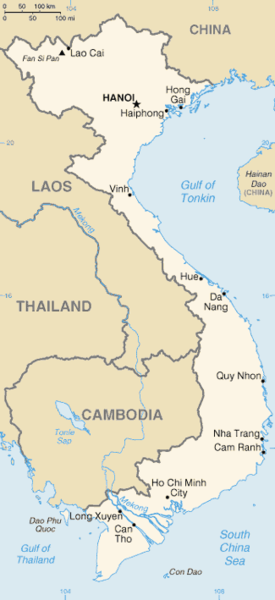
Sex trafficking in Vietnam is human trafficking for the purpose of sexual exploitation and slavery that occurs in the Socialist Republic of Vietnam. Vietnam is a source and, to a lesser extent, destination country for sexually trafficked persons.













